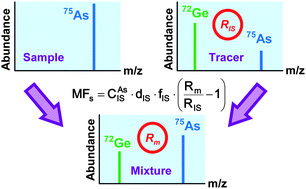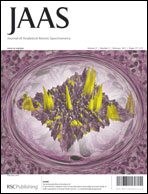In the present work, internal standardization based on species-unspecific isotope dilution analysis technique is proposed in order to overcome the matrix effects and signal drift originated in the speciation of As in urine by HPLC-ICP-MS. To this end, 72Ge has been selected as a pseudo-isotope of As. The resulting mass flow chromatogram of the element allows the calculation of the corrected overall species concentrations without requiring any methodological calibration, providing high-throughput sample processing. The validation was carried out by analyzing a blank human urine fortified at three concentration levels and an unspiked human urine sample containing different species of arsenic. In all cases, recoveries ranging from 90 to 115% and RSD below 10% were attained with this approach. Furthermore, the proposed method provided results in excellent agreement with those obtained using standard additions and internal standard calibration, allowing a fast way to assess human exposure to arsenic species.

You have access to this article
 Please wait while we load your content...
Something went wrong. Try again?
Please wait while we load your content...
Something went wrong. Try again?


 Please wait while we load your content...
Please wait while we load your content...